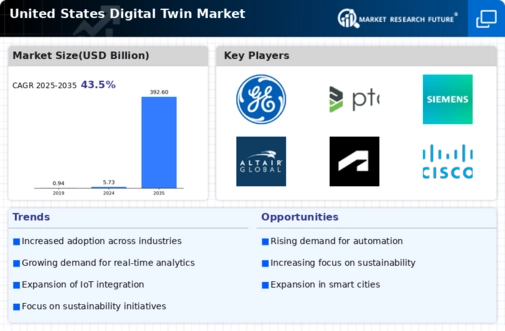Enhanced Operational Efficiency
The United States Digital Twin Market is experiencing a surge in demand due to the need for enhanced operational efficiency across various sectors. Organizations are increasingly adopting digital twin technology to optimize processes, reduce downtime, and improve resource allocation. For instance, manufacturing companies are leveraging digital twins to simulate production lines, which can lead to a potential reduction in operational costs by up to 30%. This trend is indicative of a broader movement towards data-driven decision-making, where real-time insights from digital twins facilitate proactive management. As industries strive for greater efficiency, the digital twin technology becomes a pivotal tool in achieving these objectives, thereby driving growth in the United States Digital Twin Market.
Advancements in Simulation Technologies
Advancements in simulation technologies are driving innovation within the United States Digital Twin Market. The development of more sophisticated simulation tools enables organizations to create highly accurate digital representations of physical assets. This is particularly evident in sectors such as aerospace and defense, where precision is paramount. Enhanced simulation capabilities allow for more detailed analysis and testing of products before they are manufactured, potentially reducing development costs by up to 15%. As these technologies continue to evolve, they are expected to unlock new applications and use cases for digital twins, thereby fostering further growth in the United States Digital Twin Market.
Growing Demand for Predictive Analytics
The growing demand for predictive analytics is significantly influencing the United States Digital Twin Market. Companies are increasingly seeking ways to anticipate future trends and behaviors, which digital twins facilitate through advanced simulations and modeling. Industries such as automotive and aerospace are utilizing digital twins to predict maintenance needs and optimize design processes, potentially reducing time-to-market by 25%. This predictive capability is crucial for organizations aiming to stay competitive in rapidly evolving markets. As the appetite for data-driven insights continues to rise, the digital twin technology is poised to play a central role in shaping strategic initiatives, thereby driving growth in the United States Digital Twin Market.
Integration with IoT and AI Technologies
The integration of digital twin technology with Internet of Things (IoT) and Artificial Intelligence (AI) is a significant driver in the United States Digital Twin Market. This convergence allows for the creation of highly sophisticated models that can analyze vast amounts of data in real-time. For example, in the energy sector, digital twins are utilized to monitor and optimize the performance of power plants, potentially leading to a 20% increase in energy efficiency. The synergy between these technologies not only enhances predictive maintenance capabilities but also fosters innovation in product development. As organizations increasingly recognize the value of interconnected systems, the demand for digital twin solutions is likely to escalate, further propelling the United States Digital Twin Market.
Regulatory Compliance and Risk Management
Regulatory compliance and risk management are becoming increasingly critical in the United States Digital Twin Market. As industries face stringent regulations, digital twins offer a means to simulate various scenarios and assess compliance with safety and environmental standards. For instance, in the construction sector, digital twins can model building performance under different conditions, ensuring adherence to regulations while minimizing risks. This capability not only aids in meeting compliance requirements but also enhances overall project management. As organizations prioritize risk mitigation strategies, the adoption of digital twin technology is likely to expand, further contributing to the growth of the United States Digital Twin Market.
























Leave a Comment